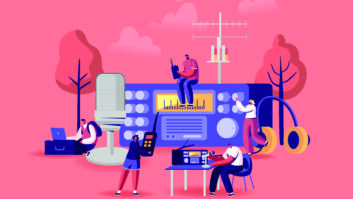With the hunt on to find business models to replace declining ad revenue, it is not the most advanced or coolest technologies that will succeed but the ones that support winning business models.
This does not diminish the importance of tech, because every new business model being put to test is powered by a new enabling technology. How will your station make money in the coming years? A second HD channel? Streaming content over the Web? Sponsored podcasts? Social media?
All are powered by technologies to which the radio market did not have access 10 years ago.
The idea for the Wheatstone study “Revenue-Generating Radio Technologies: A Progress Report” was to ask the people implementing these revenue-generating technologies — yes, the tech people — how the process is going. This study got people thinking, which was what we were hoping for.
Here are five things we learned:
1. Radio Is a Divided Camp Over the Profitability of Streaming — The most discussed finding was about radio stations streaming programming over the Internet. Of the 10 revenue-generating technologies we measured, respondents picked streaming as both the most frequently used and the one with the most revenue potential (Fig. 1).

When the study was reviewed on blogs and articles, readers responded. Posts to trade publications discussed whether streaming could be profitable given the expense of music license fees. Comments on Jaye Albright’s Breakfast Blog discussed how to consider the expense of paying for each listener’s bandwidth.
Paul Thurst wrote on his Engineering Radio blog that if stations don’t make streaming work, someone else will: “One thing that Internet sites like Pandora have shown, radio broadcasters cannot sit back and be content with the status quo. Without technical innovation and some outside-of-the-lines thinking, radio will be bypassed by newer, more interactive media services.” And yes, some just loved the finding, with the Triton Media blog calling the study a “must read.”
This divide over streaming is documented in the chart in Fig. 2. Here we see both standalone and group-owned stations affected.

A little more than one in four respondents say they are making money charging for advertising right now, with another third believing they will be doing so within three years. But as the timeline extends to six, 10 and 15 years out, the numbers drop to single digits. Finally, more than a quarter of respondents believe their station(s) will never be able to charge for advertising on streamed content.
From a research point of view, it can be uncommon to find this kind of an opinion divide in an audience that shares many other common values. How can it be that so many are making money at this now, yet many believe they never will?
Gary Kline, vice president of engineering and IT at Cumulus Media, in a quote from the study, puts this into perspective: “None of these technologies will make money for your station unless they are combined with the right tools to monetize them. You need to have the right people, resources, technology training, sales training and company-wide education. For example, what good is a large investment in streaming going to do for you if your sales force is not prepared to properly sell it?”
Selling ad space for a streamed product is very different. The bad news is that the station cost structure is different, with expense added for every listener. The good new is that the media sale is different; media salespeople can go on calls with far more data about your listeners.
2. Three Years Out, More IT Networking Is Coming — We used the “three-year-out” metric in several questions because it is an unofficial high-tech research yardstick. Beyond three years, advancing technology, rising processing speeds and lower storage costs add too much uncertainty for accurate predictions.
Group-owned stations are advancing more quickly but standalone stations are not far behind.
That said, three years out there will be more automation; more audio consoles networked together; more radio stations networked together; more IT networks at stations integrated together; and more integration between office and audio IT systems.
Fig. 3 is one of the “three-years-out” charts from the study.

3. AoIP Is Not Always Living Up to the Hype — Many stations have found AoIP networks to be more challenging than anticipated. Over a third (36.4 percent) of respondents from standalone stations with AoIP networks found installation “harder than anticipated.”
By contrast, group-owned stations, where AoIP experience can be borrowed from a central IT department or another station, found installations far easier, with only 16.7 percent finding installation “harder than anticipated” (Fig. 4).

In the study, Mike Cooney, vice president of engineering and chief technology officer of Beasley Broadcast Group, confirms this with an experience of his own.

“My first (AoIP) installation was about five years ago. It was probably one of the first installations of its kind and it did not go smoothly. It was a learning curve on our part, and on the manufacturer’s part, as it was a new product. [Installing] the same exact system a year ago went absolutely smooth with no troubles at all. Neither system caused any problems after it was installed, but the first installation was harder because of the learning curve.”
Another surprise came when we asked stations with AoIP networks if they had latency problems. Standalone stations, whose systems tend to be smaller, had fewer issues, but one in three group-owned stations reported latency problems (Fig. 5).
Latency, or audio delay, can annoy talent when their voice in their headphones has a delay as they talk. It can become more than an annoyance when it interferes with an automation system. Latency can cause ad spots to be dropped and satellite feeds to be missed.
4. Within 15 Years, Tech People Believe a Majority of Listeners Will Be Via the Internet, Not RF — As we look ahead, for every few years we measured we found a few more respondents who believe that their stations would have more listeners from their Internet stream instead of their RF signal.
Although the number of respondents picking streaming was small, with each passing time unit they added up. When we total the number of people who believe they will have more Internet listeners within 3, 6, 10 and 15 years, combined they became a majority. Within 15 years, 61.3 percent of respondents from standalone stations and 54.8 percent from group-owned stations believe they will have more online listeners than over the air (Fig. 6).

5. Nevertheless, Transmitters Will Stay On — Despite the above, very few respondents believe their transmitters will be turned off. Keeping transmitters going will give stations a competitive advantage over online-only radio. Roughly 76 percent of respondents believe they will never turn off their transmitter (Fig. 7).

In the study, Mike Cooney agreed with the majority and raised a further question: “Which transmitters?”
“There may be a time down the road when we turn off our analog signals but continue with just our digital signals,” he said. “We will have multiple channels of digital and may make as much money transmitting data services as we do from our radio product. Because there is a lot of bandwidth in the HD signal, there could be many different services, such as the Broadcaster Traffic Consortium, where we transmit traffic data on the HD signal. By then, there could be many other kinds of data services we could be taking advantage of.”
Other radio-delivered data services could include text-based information such as song titles and artist names, weather updates, movie listings, sports scores, stock quotes and school closings.
In conclusion, many changes are coming to the tech side of radio; there is no shortage of opinion as to which of these revenue-generating technologies will win out. But radio tech people are a passionate group and have confronted change before.
Many non-tech people might prefer to sit on the sidelines and wait for the winning technologies to emerge. Programming guru and blogger Mel Phillips, after posting on the coming changes outlined in the study, commented, “Welcome to the world of technology. I’m glad I chose programming …”
Comment on this or any article. Write to [email protected].










